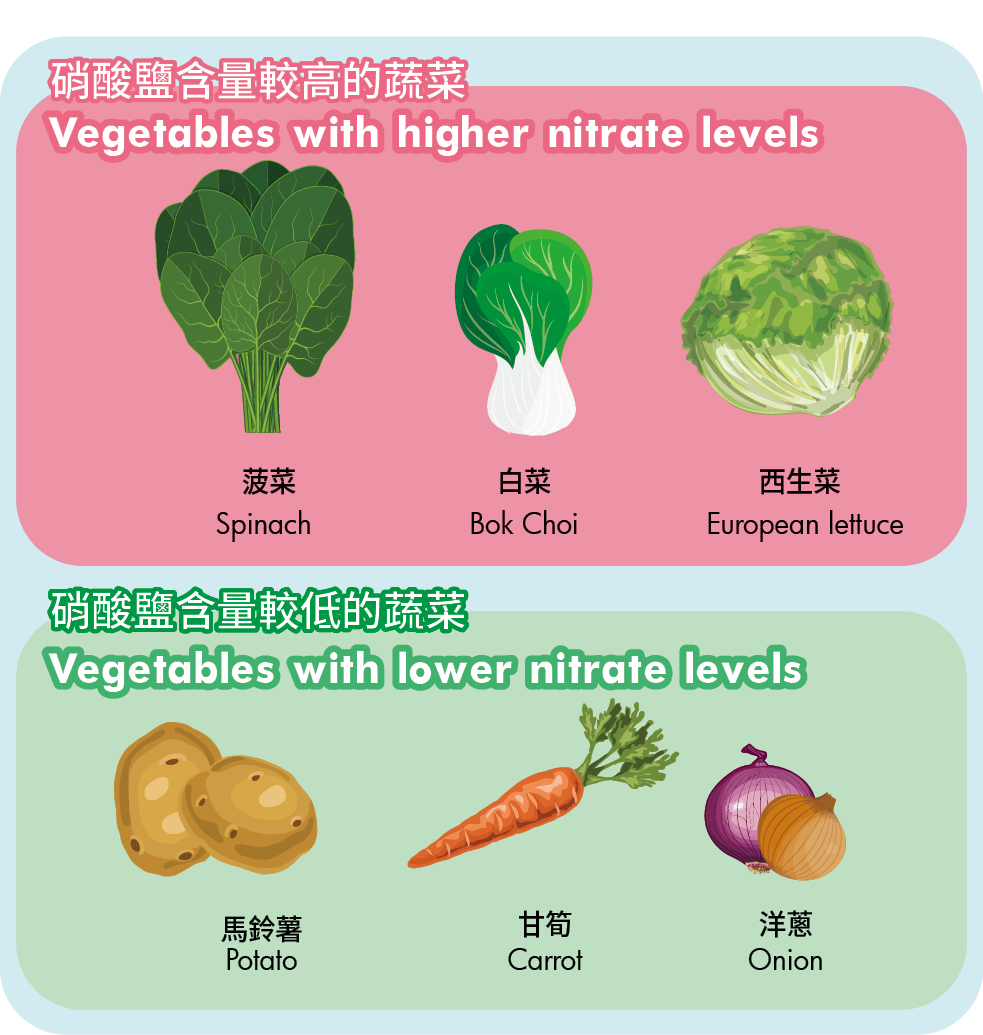
Food Safety Focus (172nd Issue, November 2020) – Incident in Focus
The Truth about Nitrate and Nitrite in Vegetables
Reported by Ms. Iris CHEUNG, Scientific Officer,
Risk Assessment Section, Centre for Food Safety
Background
Vegetables are essential components of a healthy diet since they are good sources of dietary fibres, vitamins and minerals, and have beneficial health effects against chronic diseases and cancers. However, some people may have concern on the health effects caused by the nitrate and nitrite in vegetables. Do people really have to worry about that? Let's take a closer look into the nitrate and nitrite in vegetables.
Nitrate and Nitrite in Vegetables
Nitrate is widely distributed in the nature and can be found in soil, water and food, and is a crucial nutrient for the growth and development of plants. Nitrate can be converted into nitrite naturally and the process is accelerated in the presence of bacteria. Inside the human gut, nitrate can also be metabolised into nitrite. Apart from vegetables, humans are exposed to nitrate and nitrite in many other ways such as from water and processed meats (e.g. ham and sausages) where they are used as food additives.
Nitrate concentration varies among different vegetable types. In general, leafy vegetables (e.g. cabbage and spinach) have higher nitrate concentrations, whereas root vegetables (e.g. potato and carrot) and bulb vegetables (e.g. onion and garlic) have relatively lower levels. For nitrite, its average concentration in vegetables is generally low.

Figure 1: Examples of vegetables with different nitrate levels
Health Implications of Nitrate and Nitrite
Nitrate itself is relatively non-toxic but its metabolite, nitrite, can oxidise haemoglobin in blood and render it unable to carry oxygen inside the human body. This medical condition is known as methaemoglobinaemia and affected persons will have their lips and skin turned blue. While methaemoglobinaemia are rarely seen in healthy individuals, young infants are more susceptible to it because of the immaturity of the digestive system, resulting in proliferation of bacteria and conversion of nitrate to nitrite. Also, fetal haemoglobin in young infants are more easily affected by nitrite and on the other hand they are less capable to convert the methaemoglobin back to normal state. This condition in babies is called 'blue baby syndrome'.
Nitrite may also react with amines to form nitrosamines in the body through a process known as endogenous nitrosation. Nitrosamine is potentially cancer-causing in experimental animals, but epidemiological studies do not suggest that nitrate intake from diet is associated with increased cancer risk. When nitrate is consumed through a normal diet containing vegetables, other bioactive substances such as vitamin C may inhibit the endogenous formation of nitrosamines. The European Food Safety Authority also considered that the beneficial effects of eating vegetables and fruit outweigh the potential risk to human health from exposure to nitrate through vegetables.
Factors Affecting the Nitrate and Nitrite Contents in Vegetables
- Food processing
Nitrate is soluble in water. Studies showed that the nitrate contents of vegetables decrease upon washing and boiling due to leaching of nitrate into the water. Removing high nitrate-containing parts, such as peeling the skin of potatoes, is also found to lower the nitrate contents.
Chopping or mashing of vegetables, whereby releases enzymes in the plant cells that convert nitrate into nitrite, may cause excessive formation of nitrite. Therefore, it is advisable to cook vegetables soon after these processing and infant foods such as vegetable puree should also be prepared for immediately use. - Storage condition
The nitrite concentrations in fresh, undamaged and well-stored vegetables are usually very low. Studies showed that nitrite formation tends to be inhibited under refrigeration as the activities of enzymes and bacteria are inactivated. Hence, vegetables are preferably stored in a refrigerator (at or below 4°C) if they are not cooked immediately.
Cooking can destroy the enzyme activity within the vegetables, but any subsequent bacteria contamination can result in nitrite accumulation as nitrate is converted to nitrite by the bacteria. Therefore, if you plan to store cooked food including vegetables overnight, pack the amount to be stored after cooking and before sharing among diners. Reduce the cooling time as far as possible and store it in a refrigerator within two hours. You may consider using root vegetables or bulb vegetables as their nitrate levels are generally lower.
The beneficial effects of vegetables in protecting against cancers and chronic diseases are well-recognised. The general public should maintain a balanced diet containing a variety of vegetables while handle the vegetables properly to prevent nitrite accumulation.
Key Points to Note
- Nitrate and nitrite are naturally present in vegetables and many other foods. Consumption of a high level of nitrite may cause methaemoglobinaemia and infants are more susceptible.
- Proper food processing and storage are effective in reducing the formation of nitrite in vegetables.
- While available evidence suggests that nitrate intake from diet is not associated with increased cancer risk, consuming vegetables has strong beneficial effects against chronic diseases and cancers.
Advice to Public
- Maintain a balanced diet containing a variety of vegetables for the benefits of health.
- Handle vegetables properly (e.g. keep under refrigeration; wash or peel before cooking; cook soon after chopping or mashing etc.). For vegetable puree prepared for infants, they should be consumed immediately and preferably not be stored at all.
- If you plan to store cooked food overnight, pack the amount to be stored after cooking to prevent bacterial contamination, and keep the stored food refrigerated.
Advice to the Trade
- Properly handle and store vegetables (e.g. in cool, dry places or a refrigerator if possible) to prevent damage of fresh produce.
- Regularly monitor the condition of vegetable. Remove those which are deteriorated.

